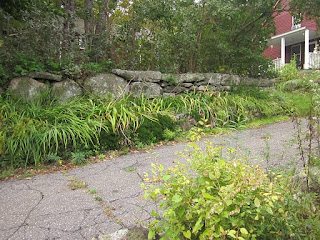Or: Just a psychological phenomenon called Pareidolia, right?
12/31/2018
The stones are stacked to resemble the scales of a Rattlesnake :
Or a Great Serpent:
"Horned serpents are a type of mythological freshwater serpent common to many tribes of the eastern United States and Canada. Horned serpent legends vary somewhat from tribe to tribe, but they are usually described as huge, scaly, dragon-like serpents with horns and long teeth. Sometimes they move about on the land, but are more often found in lakes and rivers. The ubiquity of horned serpent stories in this region has led some people to speculate that they are based on a real animal (such as some sort of now-extinct giant crocodile.) However, in Native American myths and legends, horned serpents are usually very supernatural in character-- possessing magical abilities such as shape-shifting, invisibility, or hypnotic powers; bestowing powerful medicine upon humans who defeat them or help them; controlling storms and weather, and so on-- and were venerated as gods or spirit beings in some tribes. And unlike other animals such as crocodiles and snakes, horned serpents are not included in common Woodland Indian folktales about the animal kingdom. So it is likely that horned serpents have always been viewed as mythological spirits, not as animals, and that belief in them was simply very widespread in the eastern part of the country. Indeed, horned serpent mythology may trace back to ancestors of Eastern Native American tribes such as the Hopewell, Mississippian, and other mound-builder civilizations, as stylized serpent motifs have been found in their earthworks and artifacts which bear some resemblance to the horned serpents of historical Native American tribes."
Name: Maxa'xâk
Tribal affiliation: Lenape
Alternate spellings: Mëxaxkuk, Maxaxak, Maxa'xak, W'axkook
Pronunciation: muh-khakh-kook
Also known as: Great Serpent
Type: Lake monster, serpent
Related figures in other tribes: Mishi-Ginebig (Anishinabe), Uncegila (Sioux), Apotamkin (Maliseet)
Tribal affiliation: Lenape
Alternate spellings: Mëxaxkuk, Maxaxak, Maxa'xak, W'axkook
Pronunciation: muh-khakh-kook
Also known as: Great Serpent
Type: Lake monster, serpent
Related figures in other tribes: Mishi-Ginebig (Anishinabe), Uncegila (Sioux), Apotamkin (Maliseet)

















































